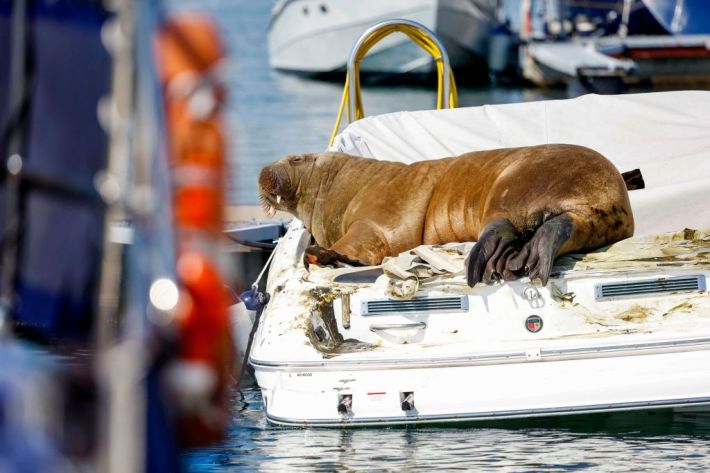Soon after Freya first arrived in Norway, she began climbing aboard pleasure boats in the idyllic coastal town of Kragerø. The young female walrus was easy to spot, with unusually tiny tusks and a small pink spot on her nose, as well as the distinction of being the only walrus around town. Freya only wanted to sunbathe on something floating, giving her body the chance to rest and digest her meal of scallops and mussels. Although an Arctic ice floe may have no problem accommodating the 1,300-pound Freya, some coastal boats capsized under the young walrus's weight, creating consternation among many boat-owners who wished Freya would skip town and stop smearing their snow-white boats with her walrus-sized poops.
In July, when Freya moved near the capital of Oslo, her celebrity ballooned. The walrus gained a more international fanbase. The Cut declared that "No One Is Having a Better Summer Than Freya the Walrus" in a story that has since aged poorly.
Freya finding the bilge pump useful (activated by Freya filling the boat in the first place 😇) pic.twitter.com/02VzN0VN76
— Knut Karlsen (@etunKo) July 19, 2022
Crowds of spectators flocked to see Freya lounge on boats. They ogled her by docks and on kayaks. The Norwegian Directorate of Fisheries repeatedly warned people to stay away from Freya. The directorate consulted a vet, who advised that all this attention meant Freya was likely not getting enough rest (walruses can sleep up to 20 hours a day). But the public ignored these warnings, with people choosing to swim with the walrus, throw objects at her, and sidle up to her for pictures. So early Sunday morning, the Norwegian government killed Freya, "based on an overall assessment of the continued threat to human safety."
Managing human and wildlife interactions is always complicated, and often emotionally difficult. It's true that an adult walrus can cause serious harm to a human even unintentionally. It's true that it is hard to control the actions of a large swath of people who, either ignorant or in defiance of explicit warnings, chose to harass and engage with a young walrus who may have otherwise kept to herself. It's true there is no universal ethical calculus to decide what to do with animals who harm or kill humans, let alone animals that have yet to harm a human but potentially could.
And yet I am infuriated that Norway killed Freya so quickly, without any escalation of the warnings toward the members of the general public who felt they deserved to have meet-and-greets with a large, sensitive wild animal from the frozen floes of the Arctic. Because it was never really a choice between animal life and human safety. It was a choice between Freya's life and the ability of the people of the Oslofjord to continue using their boats, wandering around the docks, and swimming in the waters near the walrus. It was a choice between animal life and human comfort.
Rune Aae, a biologist at the University of South-Eastern Norway, had been managing a map of Freya's sightings with the intention of helping people avoid her—although it is also possible that people used the Freya tracker to go see the walrus in person. In a Facebook post about Freya's death, Aae said he believed Freya would have left the Oslofjord of her own accord quite soon, and that the crowds of onlookers would have dispersed as school holidays ended with the summer. As Aae wrote in the post, "killing her was, in my view, completely unnecessary, and another example of a trigger-happy gun management—for which Norway is already well known."
If the authorities say killing an animal is a last resort, let it truly be the last. Show me the other tactics tried, because there seem to be dozens of alternatives. What about fining people who got too close? What about closing the marina for a week? What about trying literally anything before jumping straight to walrus murder? Everyone in Oslo could have more or less continued with their lives unbothered by Freya. Here is my opinion: If a person selfishly and recklessly ignores warnings to invade the personal space of a wild animal, the animal cannot be blamed for whatever happens next.

Olav Lekver, a spokesman for the Norwegian Directorate of Fisheries, told The New York Times that moving Freya would be "too high-risk." I ask: for whom? Not for Freya—whose only other alternative appears to have been certain death, which seems to me fairly high-risk already. Was it too high-risk for people? People regularly manage to move elephants and whales. Last week, people attempted to return an emaciated beluga that strayed into the River Seine back to the sea, guiding the whale into a crane in an operation that lasted six hours. Soon after it was lifted into a refrigerated truck to make the journey to the coast, the beluga suffered respiratory failure and had be euthanized in transit. But at least they tried.
Some people might interpret a rescue mission like that as overly ambitious, complex, or even ridiculous—a waste of resources for a single animal with no guarantee they will survive. But the thing about drastically reshaping a perfectly functioning planet for our own means and desires, leaving everyone else to live with the consequences, means that we now have to do the hard things. We changed the world for the worse, and the least we can do is accept responsibility for the creatures whose lives have been turned upside-down by our greed.
As the climate warms, it melts the sea ice where walruses haul out and gather, rest, and breed. With less ice, walruses are forced to haul out on land where they are vulnerable to predators and storms. Walrus habitat is threatened by oil drilling, operations that can trigger stampedes in the noise-sensitive animals. Norway, it bears mentioning, is Europe's second-largest petroleum producer after Russia, pumping around 4 million barrels of oil a day, according to Reuters.
This problem is bigger than walruses. As climate change scrambles and strains ecosystems around the world, altering the behavior of humans and animals, it exacerbates conflict between us. As individuals, we can act responsibly by not feeding wild animals, by giving them ample space, by never crowding them for a selfie. But institutions need to grasp that, when they tell people to leave an animal alone, and then when people inevitably do not leave it alone, it is not a green light to go ahead and kill the animal. These institutions have a responsibility to intervene, to implement actual consequences for people who do not listen, to try the expensive and ridiculous thing with the uncertain outcome. The future only holds more Freyas, and we have to be better advocates for them than we were for her.






